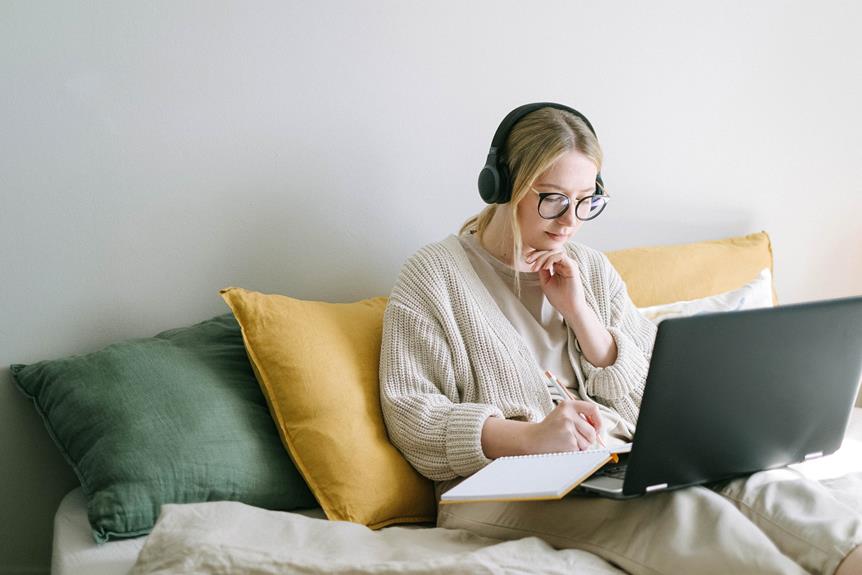You've probably heard the saying, 'Home is where the heart is.' But have you ever considered how your home office might impact your creative productivity? As more people embrace remote work, the influence of the home environment on creative output has become a focal point of interest.
Whether you're a writer, designer, or marketer, the setup and atmosphere of your home office can significantly affect your ability to generate innovative ideas and produce high-quality work. So, how exactly does your home office environment shape your creative output?
Let's explore the intriguing relationship between the two and uncover practical strategies to optimize your creative productivity in a home office setting.
Key Takeaways
- Psychological barriers such as self-doubt and fear of failure can hinder creative flow.
- Challenging negative thoughts and reframing them into positive ones can help overcome barriers.
- Experimenting with different elements like lighting and music can stimulate creativity.
- Creating a routine can enhance the ability to enter and sustain a state of creative flow.
The Psychology of Home Office Creativity
When working from home, your mindset and environment can significantly impact your creative productivity. Psychological barriers such as self-doubt, fear of failure, and distractions can hinder your ability to enter a state of creative flow. Managing your creative flow in a home office setting requires intentional strategies to overcome these barriers and optimize your productivity.
To address psychological barriers, start by acknowledging and challenging your negative thoughts. Recognize when self-doubt or fear of failure creeps in, and consciously reframe those thoughts into more positive and affirming ones. Additionally, establish boundaries to minimize distractions. This might involve creating a dedicated workspace, setting specific work hours, and communicating clearly with others in your home about your need for uninterrupted focus during certain periods.
Creative flow management involves creating a conducive environment that stimulates your creativity. Experiment with different elements such as lighting, music, or even scents to see what helps you enter a state of flow. Establishing a routine can also signal to your brain that it's time to shift into a creative mode, enhancing your ability to enter and sustain that state.
Designing an Inspiring Home Workspace
To create an inspiring home workspace, consider incorporating elements that resonate with your personal style and motivate your creativity. Start with ergonomic furniture to support your body during long hours of work. Look for a chair that provides good lumbar support and allows you to adjust the height to ensure proper alignment. Your desk should also be at a comfortable height to prevent strain on your wrists and neck.
In addition to ergonomic furniture, personalized decor can have a significant impact on your inspiration and productivity. Surround yourself with items that reflect your interests and passions. This could be artwork, plants, or meaningful objects that bring you joy. A personalized space can help create a positive and motivating environment, stimulating your creativity and making you feel more connected to your work.
Consider incorporating elements of nature into your workspace, such as natural lighting, plants, or natural materials. Bringing the outdoors inside can have a calming effect and contribute to a more pleasant and inspiring atmosphere.
Ultimately, designing an inspiring home workspace is about creating a space that not only looks good but also supports your physical and mental well-being. By incorporating ergonomic furniture and personalized decor, you can cultivate a workspace that resonates with your personal style and motivates your creativity, ultimately enhancing your productivity.
Managing Distractions and Interruptions
Eliminate distractions by creating a designated work area in your home that's separate from high-traffic areas and equipped with tools to help you maintain focus. Minimizing background noise is crucial for maintaining productivity. Consider using noise-canceling headphones or sound machines to block out distractions.
Setting boundaries with family members is also important. Communicate with your family about your work hours and the importance of uninterrupted time. Establishing a routine can help set clear expectations and minimize interruptions during your designated work hours.
It's essential to communicate the significance of uninterrupted work time, and having a dedicated workspace can help reinforce these boundaries. Additionally, utilizing tools such as a 'Do Not Disturb' sign or setting specific break times to catch up with family members can help strike a balance between work and personal life.
It's important to remember that creating a conducive work environment involves not only physical space but also clear communication and mutual respect. By implementing these strategies, you can effectively manage distractions and interruptions, allowing you to maximize your creative productivity while working from home.
Balancing Structure and Flexibility
To maintain a productive work environment and minimize distractions, it's important to strike a balance between structure and flexibility when working from home. Achieving this balance is crucial for maintaining work-life balance and ensuring remote work doesn't hinder productivity.
Here are four key points to consider when balancing structure and flexibility in a home office setting:
- Establish a Routine: Set specific work hours and break times to create a structured routine. This helps establish a clear start and end to your workday, promoting a sense of normalcy and structure.
- Flexibility within Boundaries: While adhering to a routine, allow for flexibility within those set boundaries. This could mean adjusting your work hours to accommodate personal commitments, but ensuring that you still meet your work requirements.
- Designate a Workspace: Create a dedicated workspace within your home that's conducive to productivity. Having a designated area for work helps establish a clear boundary between work and personal life.
- Regular Check-ins and Reviews: Schedule regular check-ins with your supervisor or team to maintain accountability and ensure that work is on track. This provides a structured opportunity to discuss progress and address any challenges.
Collaborative Tools and Communication Strategies
Now, let's talk about how you can effectively conduct virtual meetings.
Communicate with your remote team.
Utilize tools for remote collaboration.
These strategies are essential for maintaining productivity and creativity while working from home.
Effective Virtual Meetings
By integrating collaborative tools and employing effective communication strategies, virtual meetings can greatly enhance team productivity and engagement.
To ensure the effectiveness of virtual meetings, consider the following:
- Engaging presentations: Use visual aids and interactive tools to keep participants engaged and focused during the meeting.
- Virtual meeting etiquette: Establish clear guidelines for participation and communication to maintain professionalism and respect among team members.
- Participation dynamics: Encourage active participation from all attendees by creating an inclusive environment where everyone feels comfortable sharing their thoughts and ideas.
- Communication strategies: Utilize clear and concise language to facilitate effective discussions and decision-making, and consider utilizing breakout rooms or small group discussions to encourage collaboration.
Remote Team Communication
When fostering remote team communication, leveraging collaborative tools and implementing effective communication strategies is paramount to maintaining productivity and connectivity.
Team dynamics play a crucial role in remote engagement. Utilize collaborative tools such as project management platforms, video conferencing, and instant messaging to facilitate seamless communication.
Establish regular virtual meetings to encourage open discussions and brainstorming sessions, ensuring that every team member feels heard and valued. Implementing clear and concise communication strategies is essential for remote team success.
Encourage active participation and feedback to foster a sense of inclusivity and belonging within the team. Utilize video calls whenever possible to maintain a personal connection and strengthen team engagement.
Tools for Remote Collaboration
Fostering effective remote collaboration through the use of collaborative tools and communication strategies is essential for maintaining productivity and connectivity within a virtual team environment. To facilitate seamless collaboration, consider the following:
- Video Conferencing: Utilize platforms like Zoom or Microsoft Teams for face-to-face virtual meetings, promoting real-time interaction and idea exchange.
- Project Management Tools: Implement tools such as Trello or Asana for task assignment, progress tracking, and deadline management, ensuring transparency and accountability within the team.
- Remote Brainstorming Sessions: Engage in structured virtual brainstorming sessions using platforms like Miro or MURAL, allowing team members to contribute ideas and collaborate on a digital canvas.
- Virtual Whiteboarding: Leverage tools like Microsoft Whiteboard or Jamboard for visualizing concepts, mapping out strategies, and fostering creativity in a remote setting.
Self-Care and Wellbeing for Creative Productivity
To maintain creative productivity, prioritizing self-care and wellbeing is essential for sustaining inspiration and mental clarity. Implementing wellness routines into your daily life can significantly impact your creative output.
Establishing a consistent schedule for self-care activities, such as exercise, meditation, or engaging in hobbies, can help manage stress and prevent burnout. Mindfulness practice is another powerful tool for enhancing creative productivity. Taking time for mindfulness exercises, such as deep breathing or guided meditation, can improve focus and alleviate mental fatigue, ultimately boosting your creativity.
Work-life balance is crucial for maintaining overall wellbeing and sustaining creative energy. Setting boundaries between work and personal time, as well as creating designated workspaces within your home, can help prevent the blurring of lines between professional and personal life, reducing stress and promoting a healthier mindset.
Additionally, taking regular breaks throughout the workday is essential for preventing mental exhaustion and fostering creativity. Engaging in activities that bring you joy and relaxation during these breaks can refresh your mind and provide new perspectives for your creative projects.
Incorporating these self-care practices into your routine can lead to improved creative productivity and overall satisfaction with your work. By prioritizing your wellbeing, you're investing in your ability to consistently produce high-quality, innovative work.
Frequently Asked Questions
What Are the Best Types of Furniture and Decor to Enhance Creativity in a Home Office?
When creating your home office, consider furniture selection and color psychology. Choose ergonomic chairs and desks that inspire productivity. Incorporate vibrant colors like blue for focus and yellow for creativity. Balance functionality with aesthetics for optimal creativity.
How Can I Effectively Set Boundaries With Family Members or Roommates While Working From Home?
When working from home, set clear boundaries with family or roommates by communicating your needs and privacy concerns. Establish designated work hours and spaces, and have an open discussion about family dynamics to ensure mutual understanding.
What Are Some Recommended Time Management Techniques for Maintaining a Healthy Work-Life Balance in a Home Office?
To maintain a healthy work-life balance in a home office, start by implementing time blocking and the Pomodoro technique. Create an ergonomic workspace with natural lighting, and set clear boundaries with family or roommates for uninterrupted focus.
Are There Any Specific Digital Tools or Software That Are Particularly Beneficial for Collaborative Creative Work in a Home Office?
You'll find digital collaboration tools like Miro or Trello helpful for remote brainstorming. Asana and Slack are great for creative project management and virtual team communication. These tools streamline collaboration and enhance creative productivity in a home office.
What Are Some Self-Care Practices That Can Help Boost Creativity and Productivity While Working From Home?
To boost creativity and productivity while working from home, incorporate mindfulness practices for focus and take creative breaks like stretching or doodling. These self-care practices can help refresh your mind and enhance your work.




